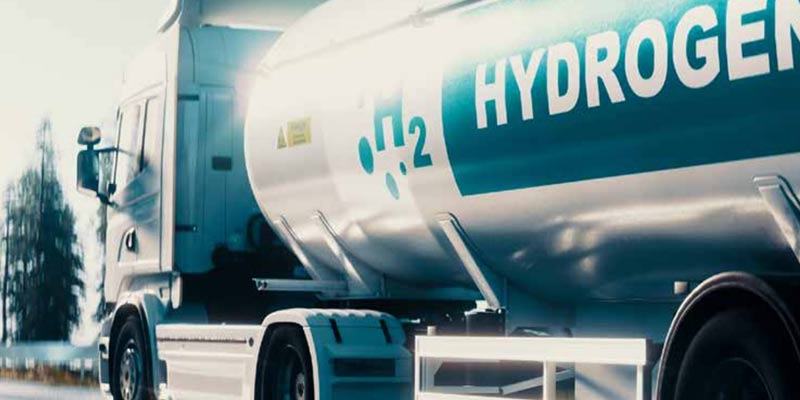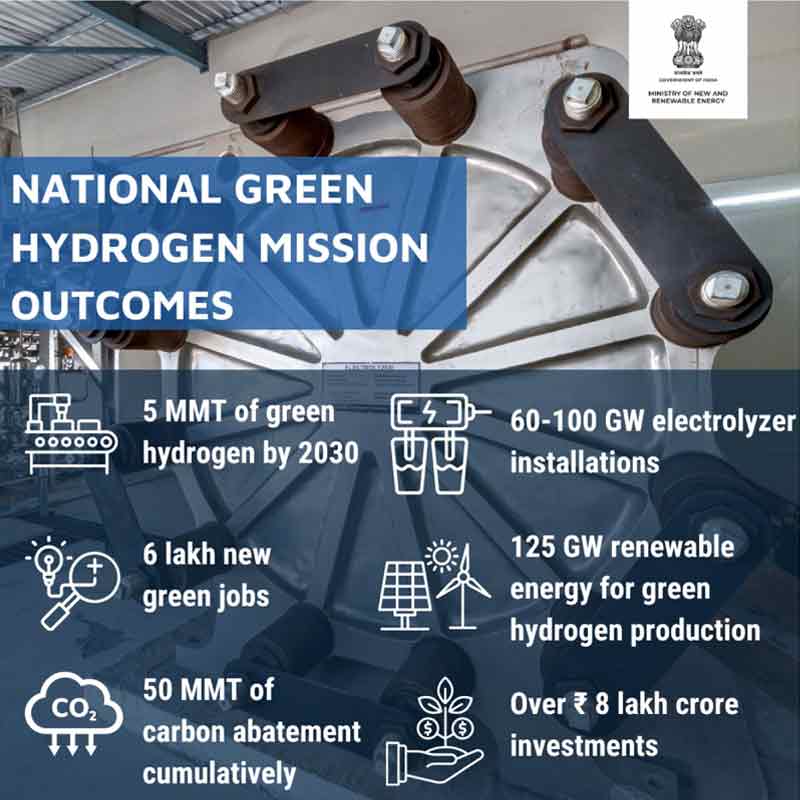- India
- Apr 27
SJVN launches India’s first multi-purpose green hydrogen pilot project
• Satluj Jal Vidyut Nigam (SJVN) has established India’s first multi-purpose (combined heat and power) Green Hydrogen pilot project at 1,500 MW Nathpa Jhakri Hydro Power Station (NJHPS) in Himachal Pradesh’s Jhakri.
• SJVN chairman and managing director Geeta Kapur inaugurated a 20Nm3/hr electrolyzer and 25kW fuel cell capacity-based green hydrogen pilot project.
• The green hydrogen produced from the project will be utilized for high-velocity oxygen fuel (HVOF) coating facility of NJHPS to meet its combustion fuel requirements. In addition, it will also generate electricity through its fuel cell of 25 kW capacity.
• It will produce hydrogen gas by splitting hydrogen and oxygen from water with the help of an alkaline electrolyzer of 20Nm3/hr capacity by utilising renewable energy supplied from the 1.31 MW solar power plant of SJVN located in Wadhal, Himachal Pradesh.
• The pilot project is set to produce 14 kg of green hydrogen daily during eight hours of operation, which will be stored in six storage tanks.
SJVN Limited
• SJVN Limited is a Miniratna (Category-I) and Schedule ‘A’ Central Public Sector Enterprise (CPSE) under administrative control of the ministry of power.
• It was incorporated on May 24, 1988 as a joint venture of government of India and government of Himachal Pradesh to plan, promote, develop all forms of power, both renewable as well as non-renewable and all ancillary activities related thereto, in India and abroad.
• Beginning with a single project and single state operation (India’s largest 1,500 MW Nathpa Jhakri Hydro Power Station in Himachal Pradesh), SJVN is currently implementing hydroelectric projects in Himachal Pradesh, Uttarakhand, Maharashtra, Uttar Pradesh, Punjab, Gujarat, Arunachal Pradesh, Rajasthan, Assam, Odisha, Mizoram and Madhya Pradesh in India besides neighbouring countries — Nepal and Bhutan.
• Apart from hydropower, SJVN has also ventured into thermal, wind power, solar power and transmission.
What is green hydrogen?
• Although hydrogen is the lightest and most abundant element in the universe, it is rarely found in nature in its elemental form and always must be extracted from other hydrogen-containing compounds. It also means that how well hydrogen contributes to decarbonisation depends on how clean and green the method of production is.
Based on the sources and processes, hydrogen can be classified into various colours:
i) Black/Brown/Grey hydrogen is produced by coal or lignite gasification (black or brown), or via a process called steam methane reformation (SMR) of natural gas or methane (grey). These tend to be mostly carbon-intensive processes.
ii) Blue hydrogen is produced by natural gas or coal gasification combined with carbon capture storage (CCS) or carbon capture use (CCU) technologies to reduce carbon emissions.
iii) Green hydrogen is produced using electrolysis of water with electricity generated by renewable energy. The carbon intensity ultimately depends on the carbon neutrality of the source of electricity. Which means, the more renewable energy there is in the electricity fuel mix, the “greener” the hydrogen produced.
National Green Hydrogen Mission
In January 2023, Prime Minister Narendra Modi-led Cabinet approved the National Green Hydrogen Mission with an outlay of Rs 19,744 crore.
The Mission is expected to attract Rs 8 lakh crore of investment in the green hydrogen chain.
India aims to produce 5 million tonnes of green hydrogen per annum in the next five years and the incentives would help bring down the cost.
Significance of this Mission
• India has a unique opportunity to become a global leader in the hydrogen energy ecosystem. With proper policy support, industry action, market generation and acceptance, and increased investor interest, India can position itself as a low-cost, zero-carbon manufacturing hub, at the same time fulfilling its goal of economic development, job creation, and improved public health.
• The current impetus surrounding the hydrogen transition fits well within the context of a low-carbon economy, energy security, and the larger economic development ambition of the nation.
• Hydrogen demand in India could grow more than four-fold by 2050, representing almost 10 per cent of global hydrogen demand. Initial demand growth is expected from mature markets like refinery, ammonia, and methanol, which are already using hydrogen as industrial feedstock and in chemical processes.
• The cumulative value of the green hydrogen market in India could be $8 billion by 2030 and $340 billion by 2050.
The Mission will have wide ranging benefits:
i) Creation of export opportunities for green hydrogen and its derivatives.
ii) Decarbonisation of industrial, mobility and energy sectors.
iii) Reduction in dependence on imported fossil fuels and feedstock.
iv) Development of indigenous manufacturing capabilities.
v) Creation of employment opportunities.
vi) Development of cutting-edge technologies.
• The Mission will facilitate demand creation, production, utilisation and export of green hydrogen.
• Under the Strategic Interventions for Green Hydrogen Transition Programme (SIGHT), two distinct financial incentive mechanisms — targeting domestic manufacturing of electrolysers and production of green hydrogen — will be provided under the Mission.
• The Mission will also support pilot projects in emerging end-use sectors and production pathways.
• Regions capable of supporting large scale production and/or utilisation of hydrogen will be identified and developed as Green Hydrogen Hubs.
• An enabling policy framework will be developed to support establishment of the green hydrogen ecosystem. A robust standards and regulations framework will be also developed.
• A public-private partnership framework for R&D (Strategic Hydrogen Innovation Partnership — SHIP) will be facilitated under the Mission.
• R&D projects will be goal-oriented, time bound, and suitably scaled up to develop globally competitive technologies. A coordinated skill development programme will also be undertaken.
• All concerned ministries, departments, agencies and institutions of the central and state governments will undertake focussed and coordinated steps to ensure successful achievement of the Mission objectives.
Manorama Yearbook app is now available on Google Play Store and iOS App Store


